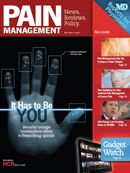Publication
Article
Pain Management
DEA Rules for eRx
Why are the DEA's rules for e-prescribing of controlled substances so stringent and, perhaps, prohibitively difficult to comply with?
An arm of the US Department of Justice (www. doj.gov), the DEA is a law enforcement operation, and thus is more concerned with preventing drug diversion than in embracing technology that makes healthcare safer and more efficient. The DEA for years has allowed verbal orders for Schedules III through V, but restricted Schedule II drugs to written prescriptions, with exceptions for emergencies. Phone calls and faxes are fine for most controlled drugs, but the idea of e-prescribing scares a lot of people in the law enforcement community.
“It is essential that the rules governing the electronic prescribing of controlled substances do not inadvertently facilitate diversion and abuse and undermine the ability of DEA, state, and local law enforcement to identify and prosecute those who engage in diversion. In this vein, DEA’s primary goals were to ensure that nonregistrants did not gain access to electronic prescription applications and generate or alter prescriptions for controlled substances and to ensure that a prescription record, once created, could not be repudiated,” the agency explains in the lengthy preamble to its interim final rule on EPCS.
“In arriving at an interim final rule, DEA has balanced a number of considerations. Chief among these is DEA’s obligation to ensure that the regulations minimize, to the greatest extent possible, the potential for diversion of controlled substances resulting from nonregistrants gaining access to electronic prescription applications and electronic prescriptions.”
According to the DEA, three to five intermediaries handle a typical e-prescription between the prescriber and the pharmacy, except in “closed” healthcare systems. “For example, a prescription may be routed to the application provider, then to a hub that converts the prescription from one software version to another to meet the requirements of the receiving pharmacy, then to the pharmacy application provider or chain pharmacy server before reaching the dispensing pharmacy. Some application providers further route prescriptions through aggregators who direct the prescription to a hub or to a pharmacy,” the preamble reads.
Each touch point presents the potential for a breach, so the agency was extra careful, even going so far as to require third-party verification of the security credentials of licensed prescribers in private practice.
That has some providers worried. “I fear there’s a potential for a physician backlash over the complexity of the rules over controlled substances,” says Joseph H. Schneider, MD, MBA, chair of the Texas Medical Association’s (www.texmed.org) ad hoc Committee on Health Information Technology. “My fear is that it is so complex that people will throw up their hands … and go back to paper.”
For more, visit the DEA page on e-prescribing (www.deadiversion.usdoj.gov/ecomm/e_rx/index. html).
